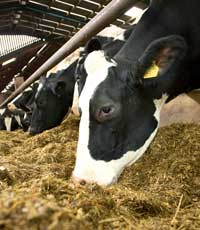Milk price increase needed to offset higher costs

Farmers Weekly has teamed up with Andersons, the farm business consultants, to explore the prospects for individual farming sectors in 2011. Here we examine the dairy sector.
Static farmgate prices and spiralling feed costs will put a significant squeeze on dairy farm profits next year.
Andersons’ “Friesian Farm” model predicts the average total cost of production for a 150-cow herd averaging 7500 litres a cow will be more than 28p/litre for the 2010/11 and 2011/12 seasons. That’s 1p/litre more than 2009/10, and almost 3p below the average UK farmgate price.
A surge in concentrate feed costs on the back of bullish cereal and protein markets is the main cause, although labour, fuel, fertiliser and straw are also costing more. This has been compounded by the dry summer and poor grass growth which prompted many producers to buy extra forage.
Those hoping for an upturn in farmgate prices on the back of firmer commodity markets are likely to be disappointed, Andersons partner Tony Evans warns. There were frequent, if modest, milk price rises in mid-2010 as bulk dairy commodity prices improved, but ongoing supermarket “price wars” will prevent further gains, he says.
He suggests all milk for liquid and cheese should be getting more than the market indicator, Actual Milk Price Equivalent, but this is not the case at present. AMPE was 28p/litre in November, while the average farmgate price is nearer 25.6p/litre.
“Unfortunately, there appears little prospect of processors being able to take additional margin from the market to pass down to producers.”
Since supermarket price promotions began in the summer, the average retail price has fallen below 50p/litre, which substantially reduces the margin available to processors and farmers, he says.
“It is not clear how much of the reduction the processors are being asked to shoulder, but the latest performance figures at Arla and a profits warning from Robert Wiseman Dairies suggest it is a significant portion. This is limiting immediate farmgate price rises, and is concerning for the future if processors try to rebuild their margins at the expense of producers.”
Direct liquid supply contracts linked to the cost of production, such as the Tesco/Promar Cost Tracker, may afford some producers a degree of protection from future cost rises, but not those producing milk on constituent contracts for cheese or manufacturing, he says.
Mr Evans also says processors need to understand that demanding a level milk production profile adds cost for farmers. “If we’re talking about an average cost of production of 28p/litre, the difference between summer and winter could be 24-32p/litre. If processors want all-year-round production they must pay the right price or accept a reduction in this approach.”
He advises farmers to review their businesses and question practices on farm. This could involve a review of contracts and pricing, reducing capital employed, or increasing the use of grazed grass to cut reliance on concentrate feeds, power, machinery and labour.
